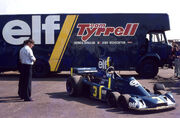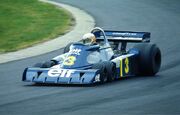
Tyrrell examining the P34 prototype

Scheckter at the 76 German GP. Note the "portholes" so the drivers could see the wheels.

A 1977 P34B at a classic meeting in 2008
The Tyrrell P34 was a Formula One car developed by Tyrrell Racing Organisation in 1976. It was notable for having six wheels, including four small front wheels that were all used for steering. The "P34" designation stood for "Project 34", or the 34th set of plans created by Tyrrell's design team, which included everything from new cars to revised aerodynamics and updated suspension designs.
History[]
Concept[]
Tyrrell designer Derek Gardner had long been searching for a solution to the aerodynamic drag generated by the tires on Formula One cars. From the large full-width nose used by the 'series 1' cars (001-004), to the smaller nose with higher fairings in front of the wheels in the 'series 2' (005-006), and then with the high fairings mounted on the wide front wings of the 007, every development had that goal in mind. He finally wondered how could someone bring the wheels entirely within the bodywork. Each solution resulted in massive understeer, until he doubled the number of front wheels. And the concept of the six-wheeled car was born.
Development[]
In early 1975, Gardner first showed team owner Ken Tyrrell some preliminary drawings. At first Tyrrell thought it some sort of prank, until Gardner's lengthy discussion of suspension geometry convinced him. The design was simple enough in that only the front two wheels were attached to the steering column, and the second wheels pivoted by use of a bell crank. The team experimented with variable cranks, so that at tracks like Monaco the wheels could turn at differing angles, but this proved to be cumbersome and unnecessary.
The guinea pig for the four front wheel concept was actually the oldest 007 chassis that the team still owned, with extra suspension points welded onto the body. The car in this form was not competitive, but it did show that the concept was viable. A full prototype was built, and this was shown to the world on September 22, 1975. The car was covered by a tarp, with a wire frame underneath, to give the initial appearance of a normal design until the tarp was lifted. Many in motorsport thought the whole thing was a prank, until they saw the car in testing, and noticed that it was setting competitive lap times.
Testing of the prototype began during a gap in the schedule a couple of weeks later, and enough data was soon gathered to start building cars for competition. One issue had been with Goodyear, as they would be required to manufacture specially sized racing tires for just this one car. Tyrrell was able to convince them that the publicity would make the effort worthwhile.
Other issues that never affected other teams had to be dealt with. The team thought that shock absorbers would have to be made to a custom size, until they discovered that heavy duty motorcycle shocks worked perfectly. While the car had a noticeable advantage in braking, getting adequate cooling air to the four front disc brakes was a constant struggle, and what worked at one circuit rarely worked at the next.
1976[]
Because of health issues, Jody Scheckter was unable to test the car much before its debut. The actual race cars had slightly longer wheelbases from the prototype. Patrick Depailler did most of the testing, so he was the first to drive the car in a race, qualifying third in Spain. Overheating brakes at the hot and twisty Jarama circuit caused him to spin into the barrier during the race. Scheckter got the next chassis built, and finished fourth in Belgium, while Depailler retired again, this time when the engine broke. Despite the car's speed, it was still regarded as a novelty, until the following race at Monaco. At the 'jewel of the crown' race, in front of a larger number of sponsors and media than anywhere else, the two P34s shone under the spotlight. They could not match the pace of Niki Lauda's Ferrari, but Scheckter and Depailler finished 2-3, a lap ahead of the rest of the field, the car's narrow track and nimble handling proving to be perfect for the street circuit. And, just to show that Monaco was not a fluke, the team scored a dominant 1-2 finish at the next race in Sweden. Ultimately the two drivers finished third and fourth in the championship, but well behind the duel between Lauda and James Hunt, while the team was third in the championship, behind Ferrari and McLaren.
1977[]
Despite all of Gardner's efforts, the car still suffered from slow straight line speed, and some amount of understeer. Gardner left the team (and motorsport) late in 1976, and former Lotus designer Maurice Phillippe replaced him before the 1977 season. A model 34B showed up, with streamlined bodywork. But testing had showed that the front wheelbase needed to be widened to help with the understeer, which put the wheels back out into the airflow. Both changes, plus adjustments needed to accommodate new driver Ronnie Peterson's 1.84m height, added weight to an already heavier-than-normal car, making the net effect a step backwards. During the season, Ken Tyrrell and Phillippe both agreed that Project 34 had run it's course, and Phillippe's first complete design for the team was the clean, simple and 4-wheeled model 008, which debuted at the start of 1978.
Race Victories[]
| Year | Event | Driver | Notes |
|---|---|---|---|
| 1976 | Sweden | Scheckter led teammate Patrick Depailler to a P34 1-2 finish |
Complete Formula One Results[]
| Complete Formula One Results | ||||||||||||||||||||
|---|---|---|---|---|---|---|---|---|---|---|---|---|---|---|---|---|---|---|---|---|
| Tyre | Driver | 1 | 2 | 3 | 4 | 5 | 6 | 7 | 8 | 9 | 10 | 11 | 12 | 13 | 14 | 15 | 16 | 17 | ||
| 1976 | ||||||||||||||||||||
| G | 4th | 2nd | 1stP | 6th | 2nd | 2nd | Ret | 5th | 5th | 4th | 2nd | Ret | ||||||||
| Ret | Ret | 3rd | 2nd | 2nd | Ret | Ret | Ret | 7th | 6th | 2nd | Ret | 2nd | ||||||||
| 1977 | ||||||||||||||||||||
| G | Ret | Ret | Ret | Ret | 8th | Ret | 3rd | Ret | 12th | Ret | 9th† | 5th | Ret | 6th | 16th | Ret | Ret | |||
| Ret | Ret | 3rd | 4th | Ret | Ret | 8th | 4th | Ret | Ret | Ret | 13th | Ret | Ret | 14th | 2nd | 3rd | ||||
| Key | |||||
|---|---|---|---|---|---|
| Symbol | Meaning | Symbol | Meaning | ||
| 1st | Winner | Ret | Retired | ||
| 2nd | Podium finish | DSQ | Disqualified | ||
| 3rd | DNQ | Did not qualify | |||
| 5th | Points finish | DNPQ | Did not pre-qualify | ||
| 14th | Non-points finish | TD | Test driver | ||
| Italics | Scored point(s) for Fastest Lap | DNS | Did not start | ||
| 18th† | Classified finish (retired with >90% race distance) | NC | Non-classified finish (<90% race distance) | ||
| 4thP | Qualified for pole position | [+] More Symbols | |||
Notes[]
In 2000, the Avon tire company agreed to manufacture some of the special front tires. Since then, the cars have been a fan favorite at historic meetings like those held at Goodwood, Lime Rock Park and Laguna Seca. One of the cars appeared in the racing sequences for the film Rush, documenting the 1976 battle between Niki Lauda and James Hunt.
| v·d·e | Nominate this page for Featured Article |
